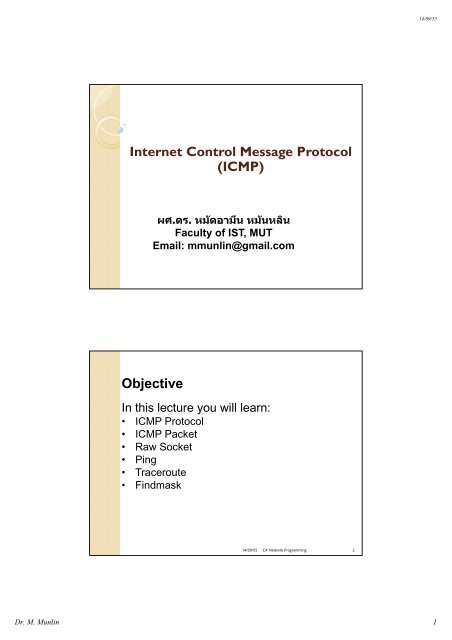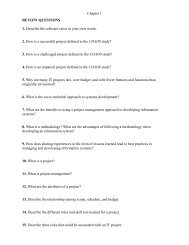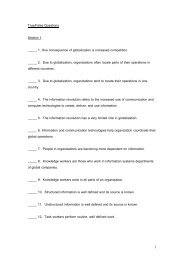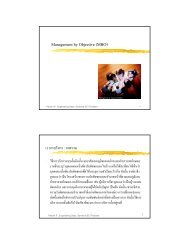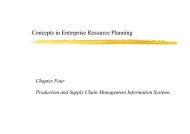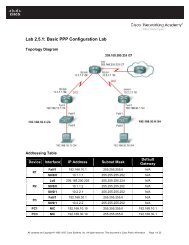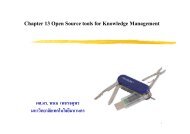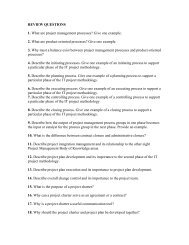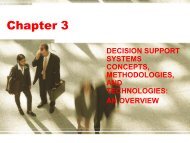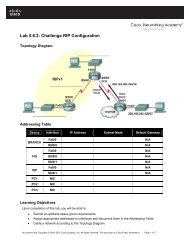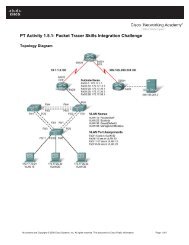Internet Control Message Protocol (ICMP) Objective
Internet Control Message Protocol (ICMP) Objective
Internet Control Message Protocol (ICMP) Objective
- No tags were found...
You also want an ePaper? Increase the reach of your titles
YUMPU automatically turns print PDFs into web optimized ePapers that Google loves.
14/09/55<strong>Internet</strong> <strong>Control</strong> <strong>Message</strong> <strong>Protocol</strong>(<strong>ICMP</strong>)ผศ.ดร. หม ัดอามีน หม ันหลินFaculty of IST, MUTEmail: mmunlin@gmail.com<strong>Objective</strong>In this lecture you will learn:• <strong>ICMP</strong> <strong>Protocol</strong>• <strong>ICMP</strong> Packet• Raw Socket• Ping• Traceroute• Findmask14/09/55 C# Network Programming 2Dr. M. Munlin 1
14/09/55The <strong>ICMP</strong> <strong>Protocol</strong>• The <strong>Internet</strong> <strong>Control</strong> <strong>Message</strong> <strong>Protocol</strong> (<strong>ICMP</strong>) is used tocommunicate with remote hosts on the network.• .Net does not have a helper class for <strong>ICMP</strong>, therefore wehave to create a separate <strong>ICMP</strong> class to encapsulate aprotocol in a class and send as a raw socket.• We can use the <strong>ICMP</strong> class in C# network programs tocreate <strong>ICMP</strong> utility programs such as ping and traceroute.• <strong>ICMP</strong> uses IP to communicate across the network.• IP packets identify the next layer protocol contained in thedata section using the protocol Type field.• <strong>ICMP</strong> packets are identified by IP protocol Type 1. Theentire <strong>ICMP</strong> packet is then contained within the datasection of the IP packet.14/09/55 C# Network Programming 3The Ethernet, IP and <strong>ICMP</strong> packet formats14/09/55 C# Network Programming 4Dr. M. Munlin 2
14/09/55IP Next Layer <strong>Protocol</strong> Field• The <strong>Protocol</strong> field is used to identify the next layerprotocol contained in the IP packet.• The IANA has defined 135 values for this field that can beused in IP packets.14/09/55 C# Network Programming 5<strong>ICMP</strong> Packet Format• Type: The 1-byte Type element defines what kind of <strong>ICMP</strong>message is in the packet. Many types of <strong>ICMP</strong> packets areused to send control request messages to remote hosts.Code: The 1-byte Code element further defines the Typefield. The various <strong>ICMP</strong> message types require specificcontrol and data options.• Checksum: The 2-byte Checksum element ensures that the<strong>ICMP</strong> packet has arrived without corruption or tampering.When computing the checksum value, the Checksum field isset to zero.• <strong>Message</strong>: The multi-bytes <strong>Message</strong> element contains variousother data elements that are unique to each <strong>ICMP</strong> messagetype. The <strong>Message</strong> data fields are often contain informationsent to and from the remote host.14/09/55 C# Network Programming 6Dr. M. Munlin 3
14/09/55<strong>ICMP</strong> Packet Types• There are many types of <strong>ICMP</strong> packets.• Each type of <strong>ICMP</strong> packet is defined by the 1-byte valuein the Type element.• the following are the <strong>ICMP</strong> types originally defined inRFC 792.14/09/55 C# Network Programming 7Echo Request Packets• Two of the <strong>ICMP</strong> packets used most often are the EchoRequest and Echo Reply.• These packets allow a device to request an <strong>ICMP</strong> responsefrom a remote device on the network, e.g. the ping utility.• The Echo Request packet uses <strong>ICMP</strong> Type 8, with a Codevalue of 0. The <strong>Message</strong> data area contains three elements:◦ A 1-byte Identifier that uniquely identifies the EchoRequest packet.◦ A 1-byte Sequence number providing additionalidentification for the <strong>ICMP</strong> packet.◦ A stream of A multi-bytes data element containing datathat should be returned by the receiving host.14/09/55 C# Network Programming 8Dr. M. Munlin 4
14/09/55Echo Reply Packets• When a device receives an Echo Request packet, it mustrespond with an Echo Reply packet, <strong>ICMP</strong> Type 0.• The Echo Reply packet must contain the same Identifierand Sequence number values as the Echo Request packetto which it is responding.• Also, the data element value must be the same as receivedin the Echo Request packet14/09/55 C# Network Programming 9Destination Unreachable Packet• The Destination Unreachable <strong>ICMP</strong> packet (Type 3) isusually returned by a router device after it receives an IPpacket that it cannot forward to the appropriatedestination.• The data portion of the Destination Unreachable packetcontains the IP header plus the first 64 bits of thedatagram.• In this packet, the Code field identifies the reason thepacket could not be forwarded by the router.14/09/55 C# Network Programming 10Dr. M. Munlin 5
14/09/55The Destination Unreachable Code Values14/09/55 C# Network Programming 11Time Exceeded Packet• The Time Exceeded (<strong>ICMP</strong> Type 11) packet has become animportant tool that is used for network troubleshooting.• It reports that an IP packet has exceeded the time to live(TTL) value defined in the IP header.• Each time an IP packet traverses a network router, the TTLvalue is decreased by 1.• If the TTL value reaches 0 before the IP packet reaches theintended destination, the last receiving router must send aTime Exceeded <strong>ICMP</strong> packet to the sending host.• This procedure is exploited in the traceroute program.14/09/55 C# Network Programming 12Dr. M. Munlin 6
14/09/55Implemented <strong>ICMP</strong> Using Raw Sockets• Because <strong>ICMP</strong> packets do not use either TCP or UDP,we cannot use either of the socket helper classes,TcpClient or UdpClient.• We have to use the raw sockets socket type of theSocket class.• Raw sockets allow us to define our own network packetabove the IP layer.• However, we have to do all the work manually to createall the individual fields in the <strong>ICMP</strong> packet, rather thanhaving the .NET library create the packet for us, as itdoes with TCP and UDP.14/09/55 C# Network Programming 13Socket Parameters• SocketTypes must match <strong>Protocol</strong>Types.• .Net does not allow to mix and match SocketTypes and<strong>Protocol</strong>Types14/09/55 C# Network Programming 14Dr. M. Munlin 7
14/09/55Raw Sockets Format• To create a raw socket, we must use the SocketType.Rawsocket type when the socket is created.• There are several <strong>Protocol</strong> Type values that we can use tomatch with the raw socket type; they are:14/09/55 C# Network Programming 15Sending Raw Packets• <strong>ICMP</strong> is a connectionless protocol, we do not have to bindthe socket to a specific local port to send a packet or use theConnect() method to connect it to a specific remote host.• We must use the SendTo() method to specify the IPEndPointobject of the destination address.• <strong>ICMP</strong> does not use ports, so the value of the port propertyof the IPEndPoint object is not important (usually 0).• The following creates a socket and an IPEndPoint destinationobject with no port and sends a packet to it:Socket sock = new Socket(AddressFamily.InterNetwork,SocketType.Raw, <strong>Protocol</strong>Type.Icmp);IPEndPoint iep = newIPEndPoint(IPAddress.Parse("192.168.1.2"), 0);sock.SendTo(packet, iep);14/09/55 C# Network Programming 16Dr. M. Munlin 8
14/09/55Receiving Raw Packets• To receive data from the raw socket, we must use theReceiveFrom() method.• Because the raw socket does not identify a higher-layerprotocol, the data returned from a ReceiveFrom() methodcall contains the entire IP packet contents.• We must extract the data from the raw IP packet to createthe <strong>ICMP</strong> packet elements.• In the IP packet, the <strong>ICMP</strong> data starts at byte 20, we haveto start reading the byte array at the 20th position in thereceived IP packet to extract the <strong>ICMP</strong> data and header.• Because the ReceiveFrom() method returns the entire IPpacket, we must declare the receiving buffer size to be atleast 20 bytes larger than the expected data.14/09/55 C# Network Programming 17Creating an <strong>ICMP</strong> Class• The raw socket does not automatically format the <strong>ICMP</strong>packet, so we must do this ourselves.• We‘ll create an <strong>ICMP</strong> class to format an <strong>ICMP</strong> packet andmanipulate the packet contents.• We can then use this <strong>ICMP</strong> class in any of the networkapplications that use <strong>ICMP</strong> packets.• The <strong>ICMP</strong> class should define a data variable for eachelement in the <strong>ICMP</strong> packet.14/09/55 C# Network Programming 18Dr. M. Munlin 9
14/09/55The Default Constructor• The default <strong>ICMP</strong> constructor creates an instance of the<strong>ICMP</strong> class but does not assign any values to the datavariables.• We’ll assign these data within the <strong>ICMP</strong> applicationprogram when we are ready to create the <strong>ICMP</strong> packet.• The following is the <strong>ICMP</strong> class and a default constructor:14/09/55 C# Network Programming 19Create an <strong>ICMP</strong> Packet• To construct a new <strong>ICMP</strong> packet, just create a new <strong>ICMP</strong>object and assign the values to the data elements:14/09/55 C# Network Programming 20Dr. M. Munlin 10
14/09/55Sending <strong>ICMP</strong> Packet• After a new <strong>ICMP</strong> object is created, we cannot directly sendthe <strong>ICMP</strong> object in a SendTo() method; it must be turnedinto a byte array.IPEndPoint iep = new IPEndPoint(IPAddress.Parse("192.168.1.2"), 0);sock.SendTo(packet.getBytes(), iep);14/09/55 C# Network Programming 21Receiving and rebuilding an <strong>ICMP</strong> Object• After sending an <strong>ICMP</strong> packet, we will get an <strong>ICMP</strong> packetreturned from the remote device.• To decipher the contents of the packet, we should createanother <strong>ICMP</strong> class constructor that can take a raw <strong>ICMP</strong>byte array and place the values into the appropriate dataelements in the class:14/09/55 C# Network Programming 22Dr. M. Munlin 11
14/09/55Display <strong>ICMP</strong> Data• After creating the new <strong>ICMP</strong> object with the receivedpacket data, we can display data elements:14/09/55 C# Network Programming 23The <strong>ICMP</strong> Checksum Method• We simply create a self-contained method for calculatingthe checksum and place it in the <strong>ICMP</strong> class to be used bythe <strong>ICMP</strong> application program.14/09/55 C# Network Programming 24Dr. M. Munlin 12
14/09/5514/09/55 C# Network Programming 25A Simple Ping Program• Ping is an important and fundamental diagnostic tool tocheck a network connectivity of a remote device.• The ping program uses the <strong>ICMP</strong> Echo Request packet(Type 8) to send a simple message to a remote host.• When the remote host receives the message, it replies withan <strong>ICMP</strong> Echo Reply packet (Type 0), which contains theoriginal message.14/09/55 C# Network Programming 26Dr. M. Munlin 13
14/09/5514/09/55 C# Network Programming 2714/09/55 C# Network Programming 28Dr. M. Munlin 14
14/09/55An Advanced Ping Program• The SimplePing has the following limitations:◦ The destination address had to be entered as an IPaddress.◦ Only one ping message was sent and received.◦ The size of the ping data was not configurable.◦ The elapsed time for the ping to process was notrecorded.14/09/55 C# Network Programming 29An Advanced Ping Program14/09/55 C# Network Programming 30Dr. M. Munlin 15
14/09/5514/09/55 C# Network Programming 31The TraceRoute Program• The TraceRoute program creates an <strong>ICMP</strong> Echo Requestpacket and then enters a loop, setting the IP TTL value toincreasing values until the destination host is reached:• Each time an Echo Request packet is sent out, the programwaits for a response.• The Type element of the return packet is examined todetermine if the packet made it to the destination.• By displaying the sending address of each packet, we canwatch each router along the path of the ping packet.14/09/55 C# Network Programming 32Dr. M. Munlin 16
14/09/5514/09/55 C# Network Programming 35The FindMask Program• The FindMask program uses another <strong>ICMP</strong> message type toautomatically discover the subnet mask of the subnet thedevice .• FindMask uses <strong>ICMP</strong> Subnet Request packet type (<strong>ICMP</strong>Type 17) to query devices on a network to determine whatthe network subnet mask is.• Each packet must have unique Identifier and Sequencevalues to distinguish it from other Subnet Request packetssent out by the device.14/09/55 C# Network Programming 36Dr. M. Munlin 18
14/09/55Query subnet• After the Identifier and Sequence field, a 4-byte integerfield identifies the subnet.• The Subnet Request packet places all zeros in this field.• A responding device on the network will replace the zeroswith the appropriate value for the subnet.• Because the value is returned as a long integer, we have toconvert it to an IPAddress object for easier reading:• The BitConverter class extracts the 4-byte value from thereceived <strong>ICMP</strong> packet and convert it to a long integervalue to later create a new IPAddress object.14/09/55 C# Network Programming 3714/09/55 C# Network Programming 38Dr. M. Munlin 19
14/09/5514/09/55 C# Network Programming 39Summary• <strong>ICMP</strong> allows a network device to quickly send queries anderror messages to other network devices.• We program <strong>ICMP</strong> using the Socket class andSocketType.Raw and the <strong>Protocol</strong>Type.Icmp property.• The ping program uses the <strong>ICMP</strong> Echo Request packet tosend a simple message to a remote host. When the remotehost receives the message, it replies with an <strong>ICMP</strong> EchoReply packet, which contains the original message.• The TraceRoute program creates an <strong>ICMP</strong> Echo Requestpacket and then enters a loop, setting the IP TTL value toincreasing values until the destination host is reached .• The <strong>ICMP</strong> Subnet Request packet type queries networkdevices to determine the configured subnet mask for anetwork.14/09/55 C# Network Programming 40Dr. M. Munlin 20


